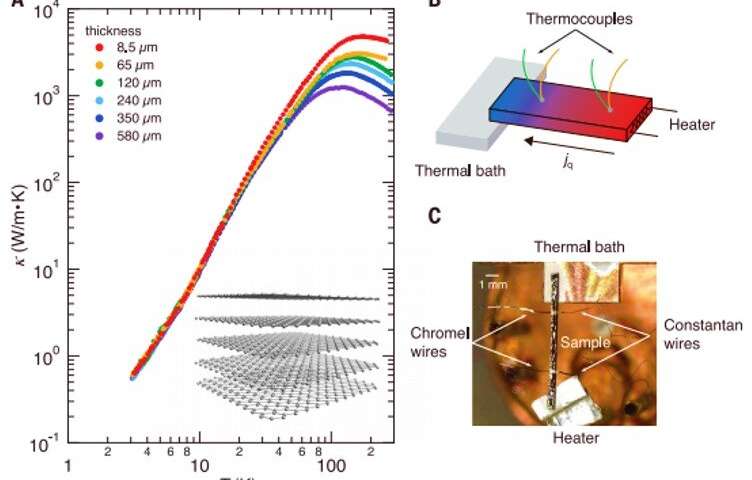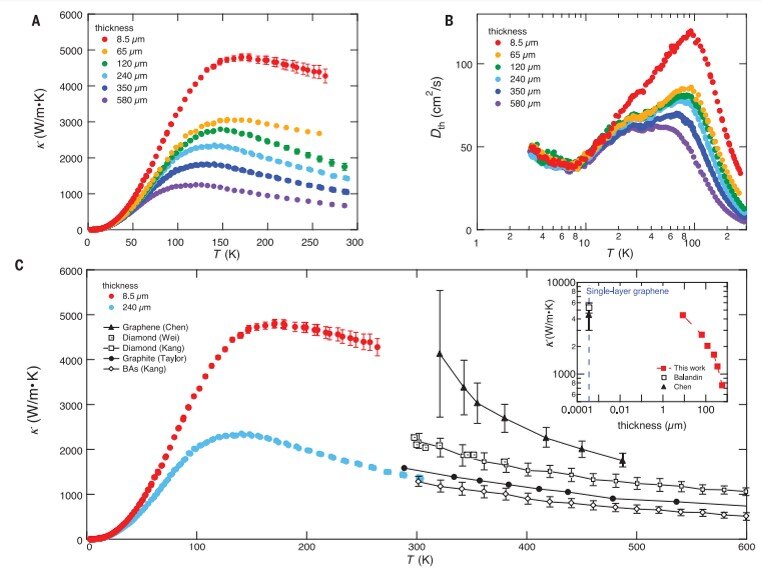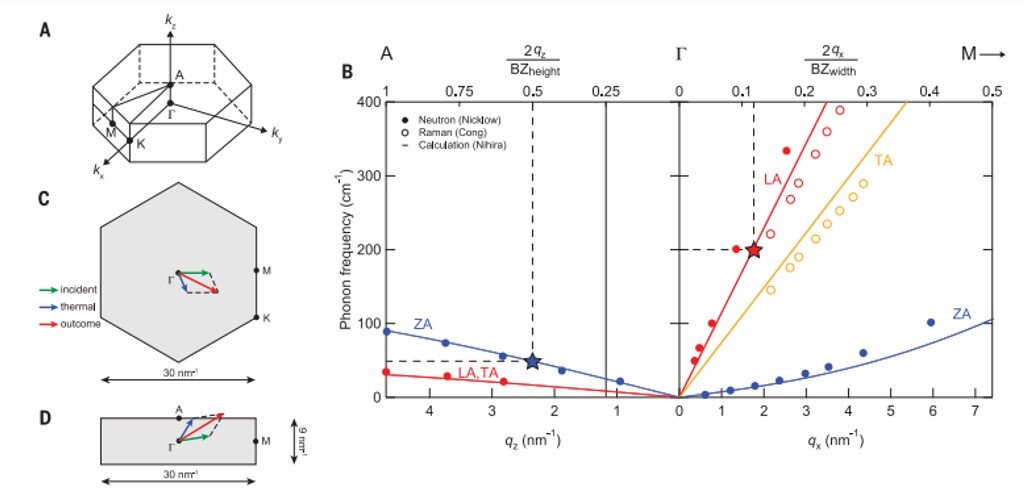
Different forms of carbon or allotropes including graphene and diamond are among the best conductors of heat. In a recent report on Science, Yo Machida and a research team in the department of Physics and the Laboratory of Physics and Materials in Tokyo and France monitored the evolution of thermal conductivity in thin graphite. The property evolved as a function of temperature and thickness to reveal an intimate link between high conductivity, thickness and phonon (atomic vibrations observed as acoustic waves) hydrodynamics. They recorded the thermal conductivity (k) of graphite (8.5 µm thickness) to be 4300 Watts per meter-kelvin under room temperature. The value was well above that recorded for diamond and slightly higher than isotopically purified graphene.
The warming enhanced the thermal diffusivity across a wide temperature range to support partially hydrodynamic phonon flow. The observed increase in thermal conductivity with decreasing thickness indicated a correlation between out-of-plane momentum of phonons and the fraction of momentum-relaxing collisions. The scientists imply these observations relate to extreme phonon dispersion anisotropy in graphite.
Propagating vibrational states of the crystal lattice known as phonons can allow heat to travel within insulators. During this transport phenomenon, quasiparticles can lose their momentum due to collisions along their trajectory. Researchers had proposed that an abundance of momentum-conserving collisions among carriers can result in the hydrodynamic flow of phonons in insulators and electrons in metals. Hydrodynamic regimes for electrons and phonons have therefore received renewed attention in order to quantify quasiparticle viscosity.
Unlike particles in an ideal gas of molecules, phonon momentum is not conserved in all collisions. For example, when scattering between two phonons produce a wave vector that exceeds the unit vector of the reciprocal lattice, excess of the momentum is lost to the underlying lattice. Physicists define such phenomena as Umklapp (U) scattering events (U events) since they require sufficiently large wave vectors. Cooling can reduce the typical wavelength of thermally excited phonons for most collisions among phonons to conserve momentum and become normal scattering events (N events).

The dominance of N events (compared to U events) across a broad temperature range in graphene allowed researchers to propose that phonon hydrodynamics may be observed at temperatures outside the cryogenic range. While heat transport measurements are challenging to study in graphene using standard four-probe steady-state techniques, physicists found evidence for second sound; a manifestation of phonon hydrodynamics, at temperatures exceeding 100 K in graphite – in agreement with theoretical expectations. Structurally, the two-dimensional (2-D) graphite lattice contained strong interlayer sp2 covalent bonds combined with weak intralayer van der Waals bonds. The coupling strength of the material and its resulting dichotomy made graphite easily cleavable to the single-layer graphene form. The nature of graphite bonding also created two distinct temperatures for in-plane and out-of-plane atomic vibrations.
Machida et al. provided new insight via a thickness-dependent study on the same material. The team measured in-plane thermal conductivity (k) of commercially available highly oriented pyrolytic graphite (HOPG) samples peeled from a thick mother sample under high vacuum. The researchers found identical k behavior for samples with thickness varying from 8.5 µm to 580 µm below 20 K. At temperatures above 20 K, they observed a steady thickness evolution for k with increasing temperature. When they compared the temperature dependence of k in the thickest sample (580 µm) with the measured specific heat, they found that k peaked around 100 K, similar to previous measurements. The observed behavior was not, however, typical in most real solids due to unequal distribution of phonon weights. The researchers expect the unusual behavior recorded in this work to have obscured the Poiseuille regime (flow driven by a pressure gradient along the length of a channel); usually associated with faster-than-cubic thermal conductivity in the material.

The team closely examined the parallel evolution of thermal conductivity and specific heat to unveil the Poiseuille regime with evolving k. They obtained a phonon hydrodynamic picture that clearly interpreted this feature—for example, warming enhanced momentum exchange among phonons, as the fraction of collisions that conserved momentum increased. The electron contribution was also negligibly small in the temperature range of interest. Since starting samples of HOPG were of an average sample quality, the work also supports the possibility for phonon hydrodynamics to occur without isotropic purity.
With decreased sample thickness, the team measured an increased k. The thinning caused amplified non-monotonic behavior of thermal diffusivity relative to the hydrodynamic regime and the scientists observed the second sound of graphite at 100 K. However, the dependence on thickness vanished below 10 K, since the phonon mean free path set by the average crystallite size did not depend on thickness. Scientists entertained the possibility of the observed thickness-independent, low-temperature thermal conductivity to originate via intrinsic scattering of phonons by mobile electrons.

The recorded in-plane thermal conductivity for the 8.5 µm thick graphite sample was ~4300 W/m·K, which exceeded the value for an isotopically pure sample of graphene. When the team reduced the thickness by two-orders of magnitude at room temperature they observed a five-fold increase in k (thermal conductivity). Results indicated that the ceiling was higher than previously expected and thinner samples with larger aspect ratios could display even larger conductivity.
While previous studies had predicted a robust hydrodynamic regime in graphene and observed its persistence in graphite, none had thus far examined the issue of thickness dependence. Machida et al. therefore further investigated the occurrence of U and N collisions for a given phonon dispersion of graphite, to understand the observed origin of thermal conductivity. They showed a reduction in the relative weight of U collisions within thinner samples to extend the hydrodynamic window and enhance thermal conductivity. The scientists could reduce the thickness by substituting a fraction of U collisions with specular boundary reflection, to limit degradation of the heat flow. They also further propose serious theoretical calculations to explain the observed findings.
